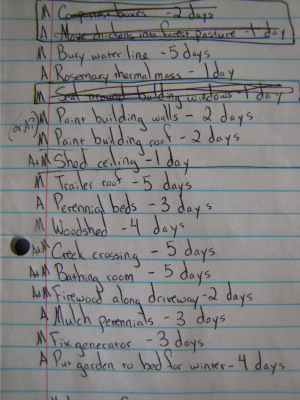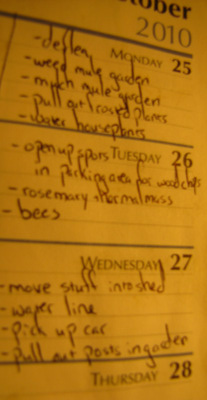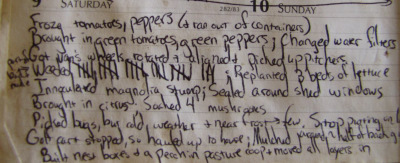
List of lists
 This
lunchtime series is really leading up to the list of lists I promised
you all a month ago --- the series of lists I use to keep myself
sane. Like the rest of this lunchtime series, this post is
primarily for the bean-counters among our readers. The other 50%
of you will probably get more out of looking at the pictures than
reading the words.
This
lunchtime series is really leading up to the list of lists I promised
you all a month ago --- the series of lists I use to keep myself
sane. Like the rest of this lunchtime series, this post is
primarily for the bean-counters among our readers. The other 50%
of you will probably get more out of looking at the pictures than
reading the words.
Without further ado, my
list of lists:
1. List
of long term goals.
2. List of one year goals.
3. Annual calendar. Many of the tasks you hope to complete this year will probably have a solid deadline --- for example, we have to finish burying our water line before the ground freezes. You may know when you're going to be too busy with day to day chores to do much long term work (April through September for us). Use the combination of deadlines and otherwise busy months to scatter the big ticket items throughout the year.

4. List of this month's (or this season's) goals. I know this list of lists is getting a bit silly, but it really works, so bear with me here! First write down all of the projects that aren't big enough to go on your one year plan but must get done that month --- for example, our fall list includes things like gathering firewood, preserving food, mulching the perennials, etc. Now, estimate how long each project will take, and figure you're going to spend about a quarter of the month working on projects you didn't think of or that spring up out of the blue --- like hauling in several loads of compost while the driveway is dry, or fixing a leak in the roof. If you are starting to overfill the month list, put spillover items on a tentative list for next month instead of lengthening the current list. Whatever you do, don't put more on your list than you can accomplish during your agreed upon working hours --- you won't have time to get even that much done, and you'll
just feel awful if you have
more on your list. (More on these agreed upon working hours in
tomorrow's post.)
time to get even that much done, and you'll
just feel awful if you have
more on your list. (More on these agreed upon working hours in
tomorrow's post.)
5. List of this week's goals. Based on your one month plan, you can now list everything you want to get done next week, including the little things that don't make it onto the month list. Write down all of the basic chores first (soaking mushrooms, weeding the garden), then fill in the most important or most timely of the month's chores. Over time, you'll learn roughly how much work you can get done in a week, and then you will be much happier. A lot of my angst in the early years came from putting two weeks' worth of work on a single week's list, and then feeling like I didn't get anything done.
6. Daily list. Now it should be simple to jot down a quick list of what you want to do today. If you have a memory, you may not even need to write it down.
7. List of this week's accomplishments. As you finish a task, mark it down on your weekly list of accomplishments. With so many balls in the air, it's easy to think that you haven't gotten anything done after spending a full week working on the farm. So whenever I finish a task, I note
it down at the bottom
of that week's page in my planner. By Friday, our list of
accomplisments is so long that I feel quite happy taking the weekend
off.
whenever I finish a task, I note
it down at the bottom
of that week's page in my planner. By Friday, our list of
accomplisments is so long that I feel quite happy taking the weekend
off.
2. List of one year goals.
3. Annual calendar. Many of the tasks you hope to complete this year will probably have a solid deadline --- for example, we have to finish burying our water line before the ground freezes. You may know when you're going to be too busy with day to day chores to do much long term work (April through September for us). Use the combination of deadlines and otherwise busy months to scatter the big ticket items throughout the year.

4. List of this month's (or this season's) goals. I know this list of lists is getting a bit silly, but it really works, so bear with me here! First write down all of the projects that aren't big enough to go on your one year plan but must get done that month --- for example, our fall list includes things like gathering firewood, preserving food, mulching the perennials, etc. Now, estimate how long each project will take, and figure you're going to spend about a quarter of the month working on projects you didn't think of or that spring up out of the blue --- like hauling in several loads of compost while the driveway is dry, or fixing a leak in the roof. If you are starting to overfill the month list, put spillover items on a tentative list for next month instead of lengthening the current list. Whatever you do, don't put more on your list than you can accomplish during your agreed upon working hours --- you won't have
 time to get even that much done, and you'll
just feel awful if you have
more on your list. (More on these agreed upon working hours in
tomorrow's post.)
time to get even that much done, and you'll
just feel awful if you have
more on your list. (More on these agreed upon working hours in
tomorrow's post.)5. List of this week's goals. Based on your one month plan, you can now list everything you want to get done next week, including the little things that don't make it onto the month list. Write down all of the basic chores first (soaking mushrooms, weeding the garden), then fill in the most important or most timely of the month's chores. Over time, you'll learn roughly how much work you can get done in a week, and then you will be much happier. A lot of my angst in the early years came from putting two weeks' worth of work on a single week's list, and then feeling like I didn't get anything done.
6. Daily list. Now it should be simple to jot down a quick list of what you want to do today. If you have a memory, you may not even need to write it down.
7. List of this week's accomplishments. As you finish a task, mark it down on your weekly list of accomplishments. With so many balls in the air, it's easy to think that you haven't gotten anything done after spending a full week working on the farm. So
 whenever I finish a task, I note
it down at the bottom
of that week's page in my planner. By Friday, our list of
accomplisments is so long that I feel quite happy taking the weekend
off.
whenever I finish a task, I note
it down at the bottom
of that week's page in my planner. By Friday, our list of
accomplisments is so long that I feel quite happy taking the weekend
off.
I'm sure
that type B people nodded off about ten paragraphs ago, but I hope that
my obsessive list of lists will help type A people find joy on the farm.
| This post is part of our Coping With Paradise lunchtime series.
Read all of the entries: |
Want more in-depth information? Browse through our books.
Or explore more posts by date or by subject.
About us: Anna Hess and Mark Hamilton spent over a decade living self-sufficiently in the mountains of Virginia before moving north to start over from scratch in the foothills of Ohio. They've experimented with permaculture, no-till gardening, trailersteading, home-based microbusinesses and much more, writing about their adventures in both blogs and books.
Want to be notified when new comments are posted on this page? Click on the RSS button after you add a comment to subscribe to the comment feed, or simply check the box beside "email replies to me" while writing your comment.

Thanks for commenting, Madeline! I hope you take the plunge sooner rather than later. If you're willing to live simply and get started with less than the perfect land, you can still find some really cheap properties down here in extreme southwest Virginia.
If you haven't been reading for too long, you might like a couple of previous lunchtime series about getting started on the farm: http://www.waldeneffect.org/blog/Where_do_I_start63/ http://waldeneffect.org/blog/Homesteading_Qualities44_Part_1/
I hope we're neighbors soon!